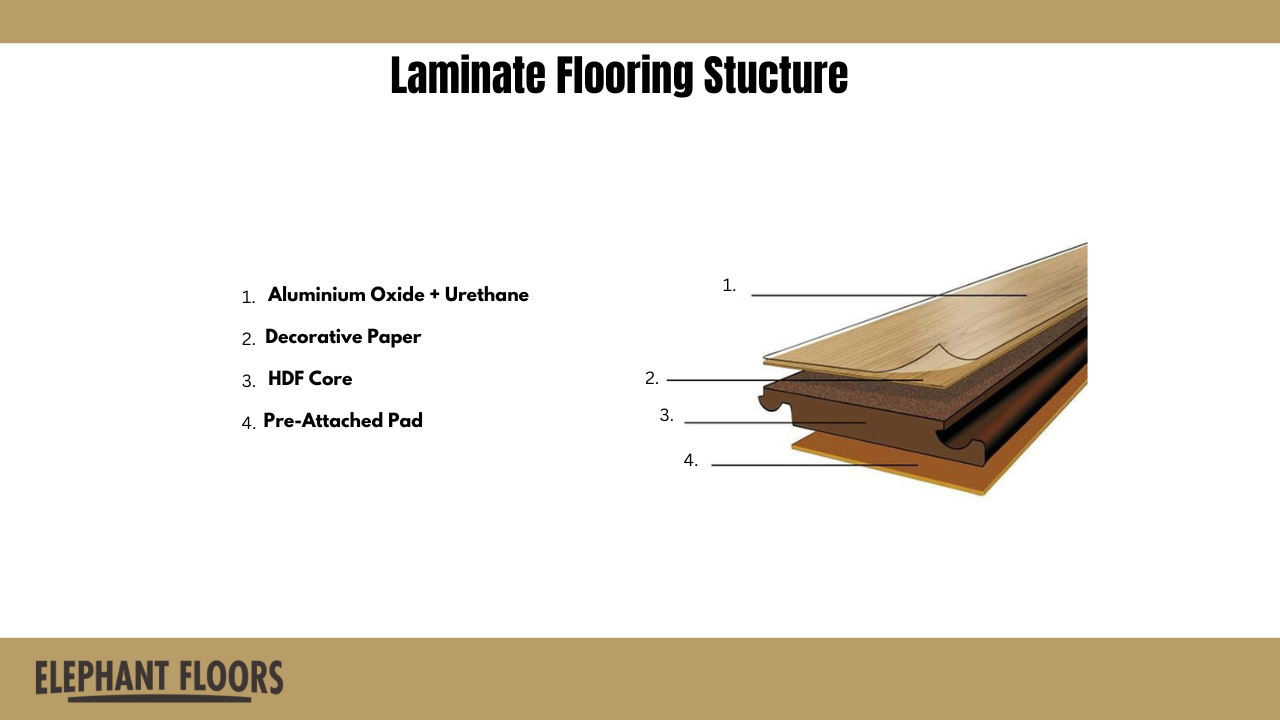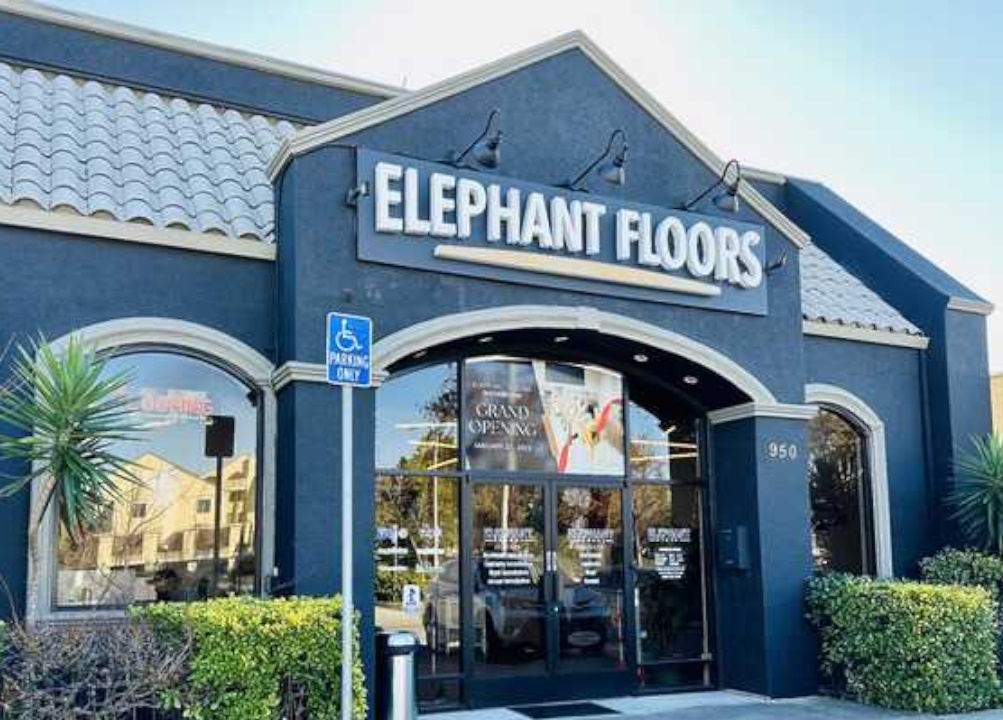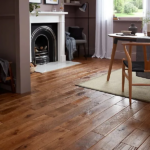- August 4, 2024
Laminate flooring is a synthetic flooring product made through a multi-layered process. It consists of a durable wear layer, a decorative layer, and a core layer providing stability. Laminate floors offer versatility and cost-effectiveness. They mimic the warmth and elegance of wood or stone without the heavy price tag.
However, like any other flooring, laminate flooring has pros and cons. Today, we’ll cover everything about laminate floors so that you can make your own evaluation and better decision.
Laminate flooring has many pros:
- Easy for DIY installation
- Requires minimal upkeep
- Available in various designs
- Doesn’t trap dust or allergens
- Cheaper than hardwood or stone
- Resistant to scratches, dents, and stains
- Laminate floorings resist moisture better than wood
- Resists fading even with prolonged sunlight exposure
- Can be installed over underlayment for a softer feel underfoot
But it comes with cons as well:
- Can’t be refinished
- Warps with excess moisture exposure
- Laminate bubbling
- Has a shorter lifespan than hardwood
- Susceptible to damage from heavy impacts or sharp objects
- Some laminate floors may sound hollow if not installed correctly
What is Laminate Flooring?
Laminate flooring is a versatile and cost-effective flooring option. It mimics the appearance of hardwood or stone. Laminate flooring consists of four primary layers. Each layer serves a specific function to enhance its durability and aesthetic appeal.
The topmost layer is the wear layer. It is a clear, protective coating that guards against scratches, stains, and fading. It ensures the flooring remains pristine over time. Beneath this is the design layer. It features a high-resolution image that replicates the look of natural materials such as wood or stone.
The core layer is made of high-density fiberboard (HDF) or medium-density fiberboard (MDF). It provides structural stability and resistance to moisture. Finally, the backing layer adds extra support and moisture resistance. It prevents the planks from warping.


These layers create a durable, attractive, and easy-to-maintain flooring solution together. This flooring is suitable for a variety of residential and commercial applications.
Top 5 Pros of Laminate Flooring
Laminate flooring has gained widespread popularity due to its many advantages. It offers a range of benefits that make it an attractive choice for homeowners.
1. Cost-Effectiveness
Laminate flooring is a popular choice among budget-conscious homeowners. Compared to hardwood and other premium flooring options, laminate is significantly more affordable. Hardwood flooring can cost anywhere from $8 to $15 per square foot. Laminate flooring typically ranges from $2 to $6 per square foot.
This price difference can result in substantial savings, especially for larger spaces. Additionally, laminate flooring installation costs are lower. Hardwood installation often requires professional expertise and extra materials. It raises the overall expense. In contrast, many laminate flooring options feature a click-lock system. It allows for easy DIY installation and reduces labor costs.
Moreover, the maintenance costs of laminate flooring are minimal compared to hardwood. Hardwood floors may need periodic refinishing to maintain their appearance. This process is both time-consuming and costly. Laminate, however, requires only basic cleaning to keep it looking its best. There is no need for refinishing.
Also Read: Laminate vs. Solid Hardwood: Which is Better?
This long-term cost efficiency makes laminate a practical, budget-friendly flooring solution. The combination of lower initial costs, reduced installation expenses, and minimal maintenance underscores its cost-effectiveness. It makes it ideal for homeowners looking to maximize their investment.
2. Durability
Durability is a key advantage of laminate flooring. It makes it an excellent choice for high-traffic areas and homes with pets. Its robust construction includes a wear layer resistant to scratches, dents, and stains. This protective layer ensures that the flooring maintains its appearance even under the stress of daily use. This flooring is particularly beneficial in busy households.
Laminate’s durability also makes it suitable for homes with pets. It can withstand the wear and tear caused by claws and active play. Unlike some other flooring options, laminate doesn’t easily show signs of damage. It helps maintain a clean and polished look over time.
This resilience extends the lifespan of the flooring. It provides long-term value and reduces the need for frequent repairs or replacements.
3. Ease of Installation
Ease of installation makes laminate flooring a favorite among DIY enthusiasts. This flooring has a click-lock installation system. This system allows the planks to snap together easily without nails or glue. It is a straightforward process. So, even those with minimal experience can install laminate flooring efficiently.
The ease of installation reduces labor costs and time. It allows homeowners to enjoy their new floors quickly. Additionally, they can even replace individual planks later if needed.
4. Variety and Aesthetics
Laminate flooring offers a wide range of styles and designs to suit any decor. This flooring can mimic the look of wood, stone, or tile. Thus, it can provide the desired aesthetic without the high cost.
Advanced printing technology ensures that the patterns and textures are convincing. They give your floors a premium appearance. This versatility allows homeowners to achieve the exact look they want. It can be a rustic wood finish or a sleek stone design.
5. Low Maintenance
Low maintenance is a top advantage of laminate flooring. It offers ease of cleaning and upkeep. With laminate flooring, maintaining a clean and pristine surface is straightforward. It requires only regular sweeping and occasional mopping.
Laminate doesn’t require specialized cleaning products or intensive maintenance routines. Instead, it can be easily cleaned with a broom or vacuum to remove dust and debris. Then, you can use a damp mop to tackle any spills or stains.
This simplicity in maintenance saves homeowners time and effort. It allows them to enjoy their floors without the hassle of constant upkeep. Additionally, the durable wear layer of laminate flooring resists scratches and stains. It further reduces the need for extensive cleaning or repairs.
Top 5 Cons of Laminate Flooring
Laminate flooring also has drawbacks that homeowners should consider. Before you choose laminate flooring, you should consider these drawbacks. They can help you decide if laminate flooring is suitable for your home.
1. Susceptibility to Water Damage
Susceptibility to water damage is a significant drawback of laminate flooring. This flooring is unsuitable for high-moisture areas such as bathrooms, kitchens, and basements. Unlike materials like tile or vinyl, laminate flooring is not inherently waterproof. It can suffer damage if exposed to excessive moisture.
Even small spills or leaks can seep into the seams and edges of laminate flooring. They can cause swelling, warping, or delamination. This vulnerability to water damage compromises the aesthetic appeal of the flooring. It also undermines its structural integrity, leading to costly repairs or replacement.
Also Read: Different Laminate Flooring Patterns
So, homeowners must exercise caution when considering laminate flooring for areas prone to moisture. They should opt for more resilient flooring options like tile or luxury vinyl in these spaces.
2. Limited Lifespan
Unlike hardwood, laminate flooring lacks the option for refinishing. And it contributes to its limited lifespan. Over time, the wear layer of laminate flooring may become damaged. This damage can occur due to scratches, dents, or other forms of wear and tear.
Hardwood can be sanded and refinished to restore its appearance. But laminate flooring requires complete replacement once the wear layer is compromised. This can result in extra expenses and inconvenience for homeowners, especially if the flooring needs to be replaced in high-traffic areas or throughout the home.
Thus, the limited lifespan and inability to be refinished remain significant drawbacks of this flooring. Homeowners should consider it when making flooring decisions for their homes.
3. Comfort and Acoustics
Comfort and acoustics are notable drawbacks of laminate flooring. It is especially noticeable when compared to carpet or engineered hardwood. Laminate flooring tends to be harder underfoot. It lacks the cushioning effect provided by softer materials. It can lead to discomfort, especially when standing or walking for extended periods.
Additionally, laminate flooring can produce a hollow sound when walked upon. Particularly if it is not properly installed or if there is inadequate underlayment. This hollow sound can be undesirable for some homeowners. It impacts the overall acoustic quality of the space.
4. Environmental Impact
The environmental impact is a significant concern associated with laminate flooring. It is primarily due to its composition of synthetic materials. Hardwood or stone are natural materials. But laminate flooring is manufactured using a combination of resins, glues, and other synthetic components.
The production process of these materials can involve the use of non-renewable resources. It also involves the emission of harmful chemicals contributing to environmental degradation.
Additionally, disposal and recycling of laminate flooring pose challenges. The materials used are not easily biodegradable and may release toxins when incinerated. It presents dilemmas for homeowners seeking eco-friendly flooring options. Laminate synthetic nature may not align with sustainable living practices.
5. Aesthetic Limitations
Laminate flooring offers a wide range of styles and designs, including realistic wood and stone patterns. However, it may lack the authentic texture and depth of natural materials. This discrepancy in appearance can result in a less upscale aesthetic. It may be noticeable to discerning homeowners or those seeking a high-end look.
Additionally, the glossy finish of some laminate flooring options may appear artificial. It may detract from the overall elegance of the room.
Laminate Floors vs. Other Flooring Options
Laminate flooring competes with various other options in the market. Each flooring type offers its own set of advantages and drawbacks. Understanding the differences helps individuals make informed decisions about durability, aesthetics, and budget.
Laminate vs. Hardwood
Laminate and hardwood flooring are different in cost, durability, and maintenance. Hardwood boasts a higher upfront cost. It often provides greater longevity and can be refinished to extend its lifespan.
In contrast, laminate flooring is more budget-friendly initially. It may need replacement rather than refinishing if damaged. Additionally, hardwood may demand more rigorous maintenance, such as regular refinishing and sealing. Laminate is generally easier to clean and maintain.
Laminate vs. Engineered Wood
Laminate and engineered wood flooring share similarities and differences in composition and installation. Both of them feature layered construction. Laminate is primarily composed of synthetic materials. Engineered wood incorporates a real wood veneer layer.
Installation methods also vary. Laminate often utilizes a click-lock system for DIY-friendly installation. Engineered wood may require professional installation due to its hardwood veneer layer.
Laminate vs. Luxury Vinyl
When comparing laminate and luxury vinyl flooring, key considerations include water resistance, cost, and durability. Both options offer water-resistant properties. Luxury vinyl generally provides superior moisture resistance. It is suitable for high-moisture areas like bathrooms and kitchens.
Laminate flooring tends to be more budget-friendly upfront. Luxury vinyl may offer better long-term value due to its enhanced durability and resistance to wear and tear.
Ready to Choose Laminate Floors?
Laminate flooring is crafted from synthetic materials. It provides a cost-effective alternative replicating the look of hardwood or stone. Despite its durability and easy installation, it’s vulnerable to water damage and has a limited lifespan.
If you’re ready to elevate your home’s aesthetic with laminate flooring, call Elephant Floors today for expert advice and more information. Our team of professionals is here to guide you through the selection process. We’ll help you find the perfect laminate flooring to suit your needs. Don’t hesitate to reach out – let us assist you in transforming your living space with high-quality laminate flooring solutions.
How long does laminate flooring last?
Laminate flooring typically lasts 15 – 25 years, depending on factors such as quality and maintenance.
Can laminate flooring be installed over existing floors?
Yes, laminate flooring can often be installed over existing floors, such as hardwood, plywood, or concrete, as long as the surface is flat, clean, and in good condition.
Is laminate flooring suitable for kitchens and bathrooms?
While laminate flooring is generally not recommended for kitchens and bathrooms, certain waterproof or water-resistant laminate options are available and can be suitable for these spaces.
What is the best way to clean laminate flooring?
The best way to clean laminate flooring is by using a damp mop or cloth with a mild cleaner specifically formulated for laminate floors, avoiding excessive moisture.
Does laminate flooring increase home value?
While laminate flooring can enhance a home’s aesthetic appeal and potentially increase its value, its impact depends on factors like property condition, market trends, and buyer preferences.




